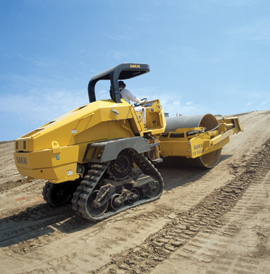There are different types of soil compactors in the market these days. The most common ones being:
- Sheepsfoot rollers, which run static, having tyres in the shapes of sheep's hoof and are typically towed,
-
Pneumatic-tired rollers, which use rubber tires to provide pressure on soil,
-
Vibratory rollers, which are used for granular and mixed soil materials; and
-
Tamping foot rollers, which have the advantages of a vibratory roller with a sheepsfoot.
The
sheepsfoot roller is highly demanded for compaction of plastic soils like clay or silt. These rollers penetrate through the loose soil material and compact the material directly with the foot tip. Pneumatic-tired rollers compact the soil from the top of the lift downward. The principle of working of vibratory rollers is by rearranging the soil from dynamic forces produced by the drum hitting the ground. A tamping foot roller also known as pad roller has feet, or pads, compacting the soil by penetrating deep into it and tilt the soil from the bottom to the top for uniform density. All these soil rollers work in accordance to their combination of vibration speed and foot shapes, thereby compacting the soil by producing a kneading effect.

Soil Roller
Large Versus Small Projects: Selection Tips
To select a particular type of roller depends on the job size, the type of material, lift thickness and the congestion in the work site. In case of a small sized projects, the soil material is usually found to be spread. Hence a little bit of compaction is required until density is achieved, which is followed by another lift of material until the whole process is done. In such a situation, the working mechanism of the compactor is more important than size, because a large sized roller may be sitting idle on the job site during the entire compaction process.
On a larger project, for instance, a highway, dam, or runway building, the compaction process is not a single day process but a continuous one. In such a case, it is important that the compactor's size and productivity match the hauling and spreading equipment on the project. Thicker lifts or or large sized rocks fill will require the large sized rollers in order to complete the project on time.
Most contractors and reputed manufacturers recommend selecting a soil roller that matches the production of your earthmoving fleet. The basic factor is weight. The roller must be able to keep up with the pace of the project. The size of your compaction equipment depends on the factors above. For example, if you need to compact thick lifts of limestone rock for a mile-long dam, you will have to get the largest vibratory roller you can get. If you are filling utility trenches on a congested site, then a mid-size tamping-foot roller is what you want. If you are building a large 20-acre pad for a new shopping mall, then a sheepsfoot roller is the best option. Its no pint running a vibratory roller in static mode on soils or base material. On the other hand, a sheepsfoot roller always runs in static mode and uses varied manipulation and impact to achieve the desired compaction of the soil.


